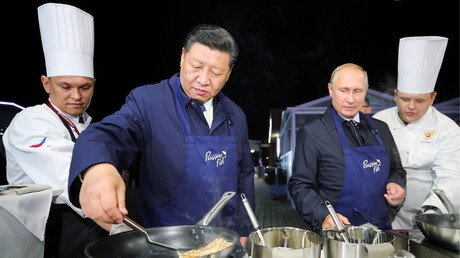How much crude oil does plastic production really consume?
The advantages of plastics over alternatives—cost and durability—will continue to drive demand for it even as governments around the world clamp down on single-use plastics.
Many social media users had a field day recently when Greta Thunberg tweeted a picture in which the 16-year-old activist was snacking on food in plastic packaging. Activists against the oil industry, the argument went, should not take advantage of the products that come from that industry.
Indeed, plastics and plastics pollution is one of the strongest arguments against the oil and gas industry. Plastics take an awfully long time to decompose naturally, and only a small amount of the plastics used on a global scale gets recycled. The problem is serious. Yet blaming crude oil alone for it is inaccurate.
Also on rt.com Buried Down Under? Australia faces trash crisis as India bans plastic waste importsLast year, 359 million tons of plastics entered markets around the world. The average portion of the total plastics output that packaging takes up is about 35 to 45 percent. This may well be less than many believe goes into plastics production, but there are even more surprising facts, and the most surprising among them is that far from all plastics are made from crude oil.
In all fairness, no plastics are made from crude oil. They are made from feedstock that is derived from crude oil, for sure, but not straight from oil. Of course, this does not have any bearing on their environmentally unfriendly properties: whether its derived from crude oil or from a crude oil feedstock, plastic still takes centuries to degrade, and in the meantime, thanks to wind and rain, they shed tiny particles that enter the food chain.
Interestingly enough, many plastics are actually made from natural gas feedstock. In the United States, for example, the most common feedstock for plastics, be it for packaging or anything else, is natural gas liquids, liquid petroleum gases, and natural gas.
Also on rt.com Oil is dead, long live oil: Plastics to drive global oil demand, say analystsThis fact itself raises questions such as, “How many barrels of oil go into plastic packaging?” A question that is quite difficult to answer. The Energy Information Administration absolutely refuses to answer it, saying that it collects no data in this segment. Yet data from a few years ago, when the EIA still collected information about this, shows that in 2010 some 191 million barrels of LPG and NGL were used for the production of plastics along with 412 billion cu ft of natural gas. The liquids amount constituted about 2.7 percent of the country’s total petroleum consumption. Most of the natural gas used in plastics production was used as a fuel rather than feedstock.
Plastics production accounts for about 4 percent of global oil production. That’s according to figures for 2012, so now it may well be higher.
But that doesn’t stop various governments from waging a full-on war on plastics, particularly in Europe, Asia—in particular China—who still are producing plastics hell-bent for leather. So is the United States: a 2017 report on global plastics found that plastic production in the United States was growing at an annual rate of 1.6 percent, while China was producing 3 percent more plastics every year on average. According to the same report, plastics for packaging constituted 19 percent of the total plastics production in 2016--the second largest segment after “Other Plastic Products”.
Also on rt.com Millennials really do ruin EVERYTHING, and Big Oil is NEXTPlastics have diverse uses, hence their still growing popularity. They are also cheaper than alternatives. The world’s plastics pollution problem is certainly grave. The Great Pacific garbage patch is real. Yet solutions are few and far between.
The advantages of plastics over alternatives—cost and durability—will continue to drive demand for it even as governments around the world clamp down on single-use plastics. While many associate that phrase with shopping bags, single-use plastics also include medical consumables, and these are not going anywhere. The same is true for the packaging of other consumer products such as electronics, but also fruit and drinks. Until we find a reliable and cost-competitive alternative to these sorts of plastic packaging, the point of how much oil—or gas—goes into plastic packaging is moot.
This article was originally published on Oilprice.com














